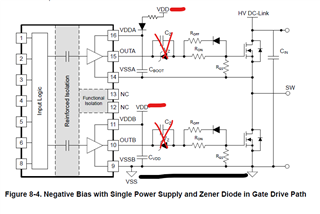Tool/software:
Hi,
I need some clarification regarding single power supply example in figure 8.4, page 33 of the UCC21550 datasheet.
1) In the single power supply configuration, VDD (12V Isolated power supply) is supplied both to VDDA and VDDB?
2) VSSA is connected to the the Switch node (V_DS)?
3) The Negative of the VDD (GND) is connected to VSSB
4) The Negative of the VDD (GND) is the same GND as the Low side MOSFET?
5) The Cz and Vz components are not required in the circuit?
6) The ROFF values needs to be lower than RON resistor?

Kind regards,
Bright
Kind regards,
Bright

